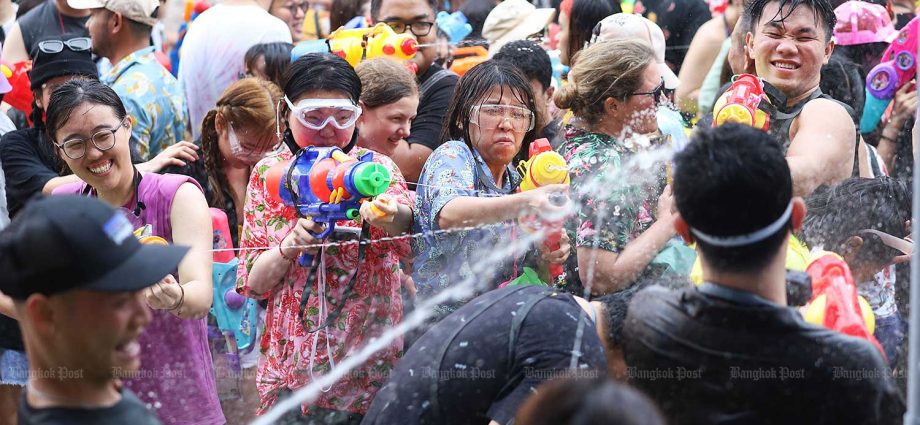Revellers mark first day of Thai New Year

Thailand yesterday officially began celebrating Songkran, or Thai New Year, with locals and foreigners alike flocking to major sites and splashing water on each other after a three-year suspension due to the coronavirus pandemic.
The Tourism Authority of Thailand (TAT) projects that up to 18.53 billion baht — from Thai and foreign tourists — will be circulated during the three-day festival, while the Kasikorn Research Centre estimates that Thai tourists alone could spend up to 23 billion baht.
In Chiang Mai, one of the country’s top destinations for Songkran celebrations, key sites such as Khu Muang and Tha Phae Gate were seen filled with tourists despite the searing heat and haze.
The celebration in this northern province began at 2pm with a traditional Songkran procession.
For a group of about 1,000 Chinese tourists who arrived in Chiang Mai and attended a formal reception organised on Wednesday night by the provincial TAT office, the festival began upon their arrival.
The tourists travelled by car and entered Thailand through Chiang Rai, Loei, Nong Khai and Nan, and at least 120,000 more are expected to follow throughout the Songkran holiday and help generate more than 1.1 billion baht in tourism-related income, Chiang Mai’s TAT office said.
In Bangkok, about 50,000 tourists headed to Khao San Road, an official Songkran celebration site in the capital that’s closed to traffic, according to Sanga Ruengwattanakul, president of the Khao San Road Businesses Association.
Hundreds of municipal officials and police officers were deployed to the area to ensure security, according to Pol Col Sanong Saengmanee, chief of Chana Songkhram police station.
Being scantly dressed, powder-smearing and having high-pressure water guns, weapons and alcoholic beverages are prohibited at this celebration spot, just like at any other, according to a source.
Silom Road wasn’t designed as a Songkran celebration site in Bangkok, but since water play isn’t prohibited on the road, it was seen packed with Thais and foreigners flocking to celebrate the water festival yesterday.
In Phuket, an unofficial Songkran celebration started on Wednesday night on Soi Bang La in the Patong area of Kathu district, one of the province’s best-known tourist districts.
Tourists, mostly Westerners, were seen enjoying a night out, spraying water at one another with water guns.
The Ratsada and Ao Chalong piers, Phuket’s two main piers, were yesterday crowded with Thai and foreign tourists from the early morning.
Most of these tourists were there for a speedboat service that would take them in and around Phuket, including neighbouring Phi Phi island in Krabi, said Thiwat Sidokbuap, deputy mayor of Phuket’s municipality.
At 5am yesterday, two ferry piers in Surat Thani were already crowded with tourists waiting to board a ferry to go to Koh Samui and Koh Phangan, the southern province’s best-known islands.
Most of the cars seen at these piers carried Bangkok licence plates, a source said.
All flights and train services from Bangkok to Surat Thani are fully booked during the Songkran period, while hotels and resorts on the province’s three main islands are about 80% full on average, said Wichawut Jinto, provincial governor, adding that more than 1.2 billion baht in tourism-related income is expected in the province during this festival.
Songkran celebrations in Hat Yai district of Songkhla, a crucial business centre in the Lower South, run day and night, particularly on Rat Uthit and Sai Sanehanuson roads.
Many shops there were yesterday seen crowded with people, many of whom had travelled from Malaysia and Singapore.
In Betong border district of Yala, Thai, Malaysian and Singaporean tourists were at the district’s iconic clock tower not only for water play but also for traditional Songkran activities.

